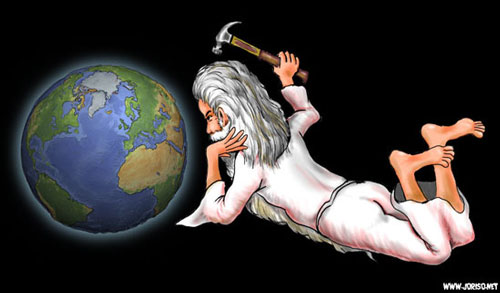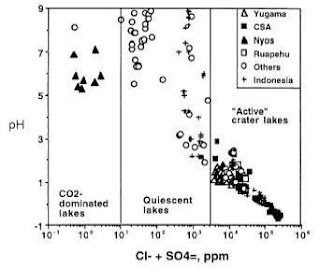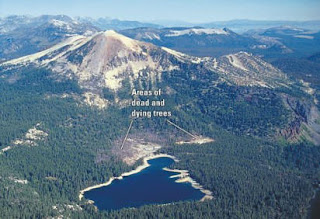-Predicting Earthquakes -
0:20:33 - The scientists in the movie use many devices to help them determine that an earthquake is about to occur. These include a robot called "spider legs", as well as some of the information described above. But just because all the signs are there does not mean an eruption is imminent. Most eruptions cannot be determined 100% until they are actually occurring. This is the reason for the debate in the movie, which resembles real life debates surrounding many geologically active volcanoes.
- Costs of Bad Predictions -
There are usually 2 choices with 3 different results for a possible large eruption:
1. Don't do anything --> volcano does not erupt
Result - Nothing, everyone is happy.
2. Don't do anything --> volcano has small eruption
Result - Most people have time to get away and not much damage to property
3. Don't do anything --> volcano has big eruption
Result - Huge loss of life and property because no one knew it was going to happen and so quickly.
One of two worst case scenarios
4. Cause an evacuation --> volcano does not erupt
Result - Cost of everyone evacuating and loss of possible tourists, since now the area is a "threat". Bad politically, and the scientists look really bad too.
The other worst case scenario
5. Cause an evacuation --> volcano has small eruption
Result - Everyone is safe and the town still looks like it has a larger problem than it really had. Not so good politically but better than nothing.
6. Cause an evacuation --> volcano has large eruption
Result - Everyone happy because they are alive although huge loss of property. Best scenario after calling an evacuation for the scientists.
- Previous Predictions and Eruptions-
0:23:35 - Previous bad eruption calls are the main reason that Harry's boss, Paul, is so worried about a wrong call. He mentions that in 1980 he was sure that Mammoth Mountain was going to erupt, which it didn't, but the tourism and everything of the town was destroyed due to the bad call. As previously listed that was one of the worse case scenarios.
Mammoth Mountain is a real volcano located within the Long Valley Caldera of California. It is similar in composition to Mount St. Helens except that it has more of a basaltic magma (Oregon State). Most scientists figured that if the mountain were to erupt that the resulting eruption would be extremely minor. In 1980 the region was hit with four magnitude 6 earthquakes along with 25 cm of dome uplift of the caldera floor. In recent years more activity followed with groups of trees being killed (pictured in the CO2 Gas Levels section above) and more gas emissions (USGS). So it seemed likely that an eruption was possible in 1980, but I can find nothing about any evacuation of the region around that time.
0:34:25 - A comparison of Dante's Peak and Mount St. Helens prompted Harry to say that if the eruption was similar it would produce a blast that could reach the town within a minute. Figuring the Mount St. Helens blast accelerated to about 300 mph, and reached about 17 miles away from the mountain, this is entirely possible if it were to happen again (USGS).
0:45:39 - Another comparison that is made is to Mount Baker in the 1970's where it was thought that Mount Baker was going to erupt and never did. Mount Baker is another stratovolcano located in the North Cascades of Washington. In 1975 activity increased substantially causing much of the glaciers to melt off of the mountain. The activity involved was only a result of heat being released with no earthquakes associated with the event (USGS). So it is likely that most volcanologists never really considered this a threat for eruption back then.
- Gas Levels -

0:25:53 - Measuring the gases is another way to determine the possibility of eruption. Gas is emitted from the volcano in a variety of ways. The first one shown in the movie is gas bubbles in the lake. This is similar to the gas bubbles in the hot spring because there are cracks in the bedrocks that likely lead directly (or indirectly) to the magma. When the magma rises and releases the gas, the gas would be the first thing to reach the surface. Another way that gas is usually released is out of the top of volcano, which is the main vent for the gas.
0:29:15 - As previously mentioned, measuring gas released from the vent is what they are doing by flying over in the helicopter and also with the robot in the volcano. In real life gasses can predict what is going on in a volcano. Usually when magma is deep in the earth the pressure keeps the gas within the magma but the closer to the surface it is, the more CO2 and SO2 is released from the magma out of the volcano. So as magma rises closer to the surface the gas concentrations in the atmosphere should also rise (PBS).
There are 2 ways to measure the gas released from a volcano. The first is what is seen in the movie, by collecting actual gas and measuring the concentrations of the different components (see picture to the right). As in the movie, the SO2 concentrations of Mount St. Helens were measured by a specially outfitted airplane. The second way is using a spectrometer which measures the light absorbed by the gas to determine the concentration of each type of gas (USGS). This method was not used by the movie. So their collection technique of flying in the helicopter should work at get a preliminary estimate, assuming the helicopter does not blow the air away from it. And even then, you still have the readings from the robot.
- Seismicity and Earthquakes -
0:35:43 - One of the machines that is used to determine a possible eruption is a seismograph.
 This is a machine that measures the size, location and type of earthquakes that are being produced around the mountain and is the best test that a volcanologist can use (PBS). When Harry is using the seismograph he stamps the ground, which produces a mini earthquake that is read on the machine. He does this to determine if the machine is working or not. The resulting image is the same thing a real earthquake would produce just on a far smaller scale. The more seismographs you have surrounding the volcano, the more accurate a reading you can get on the epicenter (location) of each earthquake. There are two typical results produced on the seismograph, both of which are the pictured below. Each result is associated with one of two main types of earthquakes that associated with volcanoes.
This is a machine that measures the size, location and type of earthquakes that are being produced around the mountain and is the best test that a volcanologist can use (PBS). When Harry is using the seismograph he stamps the ground, which produces a mini earthquake that is read on the machine. He does this to determine if the machine is working or not. The resulting image is the same thing a real earthquake would produce just on a far smaller scale. The more seismographs you have surrounding the volcano, the more accurate a reading you can get on the epicenter (location) of each earthquake. There are two typical results produced on the seismograph, both of which are the pictured below. Each result is associated with one of two main types of earthquakes that associated with volcanoes.The first type is the most common in the world and it is referred to as a tectonic earthquake (USGS). This type of earthquake is the result of two sides of a fault being pushed passed one another (see picture on the right). Now when something gets stuck in between the 2 blocks (red circle) the movement stops. The strain between the two blocks builds and builds (think of trying to break a stick and its not breaking) until suddenly the thing holding the blocks in place breaks (the stick snaps) and the plates slide past each other quickly (see bottom picture on the right). That is why in most earthquakes the initial quake is the largest and following quakes (aftershocks) are smaller (top seismograph image below).

The other type of earthquake typical of volcanoes is called a harmonic tremor (NOVA). This is produced by magma moving through the volcano causing the ground to shake consistently (seismograph below). Kind of like shaking a bowl of Jell-O steadily.

Tectonic earthquakes are common around volcanic areas because the plates that typically produce the volcano in the first place are still moving. Like in the movie tectonic earthquakes are usually no indication of a possible eruption. But it is possible for the tectonic earthquakes to lead to harmonic tremors, or in other words the tectonic earthquake moves something in the earth, which allows the magma to move up through the volcano. So again the movie is faithful to the fact that the tectonic earthquakes could lead to harmonic tremors, which is a precursor to an eruption.
0:44:45 - The depth of the earthquake is also of great importance. The shallower the quake the close to the surface the cause is, and if it is magma, you know what that means (AVO).
- Volcano Robots -
 0:36:53 - So since pretty much being able to predict an eruption is a big deal, several tools are used. Paul mentions several different machines in the movie but the main one people notice is "Spider Legs", which is a robot used to go into the crater of the volcano where it is "unsafe" for the volcanologists. The robot is able to measure gas readings, temperature and even produce a video that can be watched back at the lab. In real life NASA has actually developed these things and tested them a couple of years before the movie. The robots were aptly name Dante I and Dante II (pictured on left). (I think the name Dante more refers to the voyage of the poet into Hell rather than the movie but that is just me)
0:36:53 - So since pretty much being able to predict an eruption is a big deal, several tools are used. Paul mentions several different machines in the movie but the main one people notice is "Spider Legs", which is a robot used to go into the crater of the volcano where it is "unsafe" for the volcanologists. The robot is able to measure gas readings, temperature and even produce a video that can be watched back at the lab. In real life NASA has actually developed these things and tested them a couple of years before the movie. The robots were aptly name Dante I and Dante II (pictured on left). (I think the name Dante more refers to the voyage of the poet into Hell rather than the movie but that is just me)These robots were used for pretty much the same reason that they were in the movie, which was gas and water testing. Since most gas exuded from a volcano is heavier than air, the crater of the volcano could possibly be a toxic swimming pool of gas.
One final question to this section is, what is ELF and what does it stand for? ELF stands for extreme low frequency and we will get into it's capabilities a little later on.
- Earthquake Quantity -
0:37:17 - In the movie, during initial testing, the volcano is producing between 25 and 75 microquakes a day. The question is what are microquakes and are 25-75 really a common occurrence?
Microquake - Any quake that is below a 2 on the Richter Scale and is not detectable by a human on the surface.
Multiple microquakes in a short span of time in an active volcano is not all that uncommon. Volcanoes have been know to have more than 100 microquakes per day and still not be imminent for an eruption. Although it does cause concern and should be considered a strong warning sign (CBC).
- Changes in Size -
0:39:16 - Previously mentioned in the movie are laser beams that measure the amount of growth on the volcano. This can be produced in 2 ways. One is uplift of the crater floor and the other is actually producing what is called a lava dome. The growth of the crater bottom is also called bulging or swelling and lasers are not typically used in measuring this. Usually what is used is Electron Distance Meters (EDM), which uses infrared to bounce a beam off of the ground. This measures the change in distance between the sensor and the crater surface, similar to a laser but not quite. Some other methods include GPS which also can measure the change in height and tiltmeters which measure the change in angle of the surface (AVO).
The material that forms a lava dome is from previous small eruptions. Studying the material can give a good indication of the type of material that might erupt from the volcano in the future. If the lava dome is currently growing that means that the volcano is actively erupting and releasing some of the stored pressure, which would reduce the likelihood of a violent eruption. So studying the dome would actually provide some valuable insight into what is going on in the volcano and what could be possible in the future.
- Contaminated Drinking Water -
0:51:00 - The penultimate event before the eruption is the presence of sulfur in the drinking water. Harry states the same thing happened at Mount Pinatubo in the Philippines before it blew it's top. The eruption that the movie is referring to is the 1991 eruption of the volcano, which is considered one of the most destructive in the 20th century altering global temperatures for years to come. It also produced the largest sulfur dioxide cloud since recording began in 1978. Although I can find no evidence of drinking water contamination for this particular eruption I have no doubt it possibly occurred. Like CO2, sulfur dioxide (SO2) can also be dissolved in the water, especially when it is present in large concentrations. So prior to an eruption there will be an increase in the gases released, which would likely contaminate the local drinking water supply (USGS).
- Final Evacuation -
 0:52:55 - Although predicting volcanoes is not an exact science, enough evidence can help make predictions more accurate. After deciding to actually evacuate the town they call several different people. These include the National Guard, the mayor, and the FAA. In real life these are the three groups that should actually be notified in case of an volcanic based evacuation. The mayor is the most obvious choice since she is the one to notify the townspeople. The National Guard is the second most obvious because in the case of any national disaster they are called to help regulate all evacuation procedures (FEMA). This was the case at Mount St. Helens as well (UCDavis).
0:52:55 - Although predicting volcanoes is not an exact science, enough evidence can help make predictions more accurate. After deciding to actually evacuate the town they call several different people. These include the National Guard, the mayor, and the FAA. In real life these are the three groups that should actually be notified in case of an volcanic based evacuation. The mayor is the most obvious choice since she is the one to notify the townspeople. The National Guard is the second most obvious because in the case of any national disaster they are called to help regulate all evacuation procedures (FEMA). This was the case at Mount St. Helens as well (UCDavis).The last one is the one most people would not realize why. Volcanic ash clouds can be devastating to the propulsion system of airplanes, since ash is essentially microscopic particles of glass. These sucked into an engine can clog it up and tear it apart. Hence the reason the FAA should be one of the first to be notified so they know to adjust all air routes around the region (USGS).








 0:01:30 - The first sequence of the movie depicts an eruption in a foreign country. The eruption results in a lot of damage and the girlfriend of the main character, Harry (Pierce Brosnan), dies. There are two main activities that are associated with this eruption, mud rain and lava bombs. Later we find out that these events took place 4 years before the events of the main story and in the country of Columbia. Since the movie was made in 1997, the latest this eruption could be is 1993, but it was likely earlier than that (time for writing the script). Also there are several possibilities for volcanoes in Columbia. The picture on right shows 6 of the major Columbian volcanoes (
0:01:30 - The first sequence of the movie depicts an eruption in a foreign country. The eruption results in a lot of damage and the girlfriend of the main character, Harry (Pierce Brosnan), dies. There are two main activities that are associated with this eruption, mud rain and lava bombs. Later we find out that these events took place 4 years before the events of the main story and in the country of Columbia. Since the movie was made in 1997, the latest this eruption could be is 1993, but it was likely earlier than that (time for writing the script). Also there are several possibilities for volcanoes in Columbia. The picture on right shows 6 of the major Columbian volcanoes (
